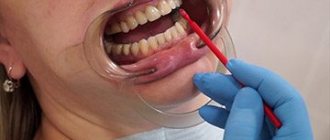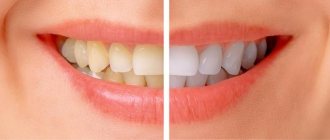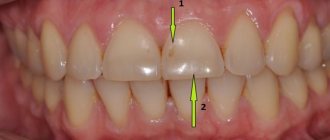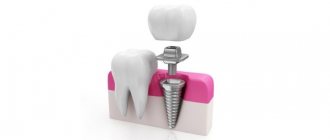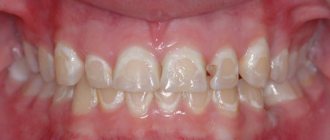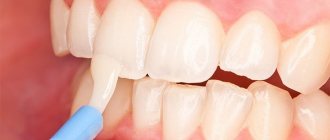Remineralization of tooth enamel is a preventative procedure. Involves strengthening hard tissues and restoring their mineral composition. Allows you to strengthen the tooth and give it a healthy appearance, reduces sensitivity. Remtherapy is painless and does not cause discomfort. It is carried out using preparations containing a complex of microelements and macroelements, as well as calcium, fluorine and magnesium.
Remineralization is carried out in two ways: application or using special mouth guards. There is toothpaste, fluoride-containing varnish, fluoride-containing discs, remineralizing gel, and also the drug Remodent. In this article we will look at the essence of dental remineralization: the causes of the problem, a description of the technique, indications and contraindications for use.
Causes of enamel demineralization
Demineralization in dentistry is the process of leaching useful substances from enamel, dentin and other hard tissues of teeth. Caused by the same reasons as for other bone tissues. The main provoking factors are metabolic disorders or deficiency of mineral compounds in the body.
Pathological leaching of useful substances from teeth is caused by the following pathologies:
- disorders of food digestion, including functional ones (for example, celiac disease);
- insufficient amount of enzymes that serve as catalysts for the absorption of nutrients;
- pathologies of the endocrine system that disrupt natural metabolism;
- improper absorption of nutrients from the intestines.
Such health problems, even with a balanced diet, lead to dental problems. Complex treatment of demineralization of hard dental tissues includes :
- diagnosis of endocrine pathologies with subsequent correction;
- treatment of gastrointestinal pathologies;
- correction of diet;
- quality dental care.
Comprehensive dental care, if necessary, includes tooth remineralization. The need for the procedure and technique is determined by the dentist.
Detailed cost
| Service | Price |
| Conducting reminirilizing therapy (per tooth) | 150 rub. |
| Fluoridation of teeth | 150 rub. |
| Preventative cleaning with Air Flow device simple (1 jaw) | RUB 2,310 |
| Preventive cleaning with Air Flow complex (1 jaw) | RUB 2,760 |
| Oral hygiene training | 1,200 rub. |
| Silvering of a baby tooth (per tooth) | 860 rub. |
| Polishing and grinding of teeth | 260 rub. |
MAKE AN APPOINTMENT
Description of the teeth remineralization method
Remineralization (remotherapy) of teeth is a method of artificially saturating hard tissues with essential microelements. Allows you to correct enamel defects, reduce sensitivity, and prevent the development of enamel caries.
Preparations and means for mineralization
The essence of the procedure is that the doctor will restore, i.e. remineralize damaged tissues using special preparations:
- special varnish (contains fluorine);
- remadent (powdery preparation containing minerals);
- Rocs remineralizing gel (allows you to maintain the strength of the enamel);
- solution for remineralization (used for applications and electrophoresis);
- fluoride discs.
When remineralizing enamel, preparations that do not contain fluoride are also used.
Types of remotherapy techniques
There are several types of remineralization:
- application (a concentrated composition for retherapy is applied to the enamel prepared for the procedure, after which the tooth is covered with a protective fluoride varnish);
- remotherapy with mouthguards (a sealed mouthguard for filling with solution is made individually for each tooth);
- deep fluoridation (involves sequential application of two solutions to the enamel: the first fills the pores of damaged enamel, the second promotes its regeneration).
For better results, use special care products: toothpaste, mouthwash, floss. This is the remineralization of enamel at home.
All types of remineralization are carried out locally and do not require anesthesia.
Types and techniques of the procedure
There are two types of remineralization of tooth enamel – natural and artificial. A natural way to saturate enamel with microelements involves changing your diet so that all useful substances enter the body with food. In this case, people begin to consume the following products:
- cheese;
- milk;
- greenery;
- cottage cheese;
- vegetables;
- nuts;
- legumes
Natural remineralization lasts a very long time, but its effect does not go away quickly. With continued adherence to your diet, your teeth will always be strong and healthy.
During natural remineralization, it is contraindicated to use toothpaste that contains fluoride, so that an excess of this element does not enter the body. Oversaturation of dental tissues with fluoride is fraught with the development of fluorosis.
An artificial method that allows you to remineralize teeth involves the use of special preparations: gels, caps, varnishes with calcium, fluoride and other microelements. Strengthening solutions are used to treat the tooth surface, as a result of which all microcracks in the enamel are filled.
Natural remineralization of teeth
Natural remineralization is suitable for those who are allergic to fluoride products. To restore enamel using this method, you need to eat the following for a month:
- fresh natural cottage cheese with a fat content of more than 5%;
- thermally processed sea fish;
- protein-rich meat;
- hard cheeses;
- pasteurized milk with a fat content of 3.2%.
All food products consumed must be natural, so it is better to purchase them not in a store, but at the market or from familiar farmers.
In parallel with natural products, you can consume vitamin and mineral complexes. It is better to choose drugs with a high calcium content that are most suitable for the patient’s age. To saturate the body with iron, you can use hematogen or special vitamins.
During the period of natural remotherapy, you should not consume sugar. The only sweets allowed for consumption are unheated honey and fruit.
Remotherapy in a medical facility
Mineralization of tooth enamel is a paid procedure that is not provided within the framework of compulsory medical insurance (compulsory health insurance), so it can be carried out both in a commercial clinic and in a self-supporting department of a budget clinic. The procedure is inexpensive, its exact cost depends on the institution where the session is performed, the number of teeth being treated and their actual condition.
Remotherapy takes place in several stages:
- Preparing the enamel for the procedure: cleaning from plaque, applying special abrasives, professional teeth cleaning with ultrasound.
- Application of calcium gluconate solution to the treated surface.
- Application of a mineralizing solution of sodium fluoride (2 or 4%) or putting on a mouth guard with a medicinal composition.
- The use of electrophoresis with remineralizing agents. Electrophoresis is used in particularly advanced cases so that medicinal compounds penetrate into the deep layers of enamel and dentin.
Remineralization of tooth enamel at home using gels and pastes
Each person can carry out the procedure to saturate tooth enamel with microelements on their own at home, but before doing so, they should consult a doctor. The dentist will recommend the best drugs for remineralization, and will also indicate the exact time during which treatment should be carried out.
Remineralizing toothpastes
The most famous remineralizing toothpastes include:
- Splat Biocalcium.
- Vivax Dent.
- Elmex.
- Lakalut Alpin.
- Lakalut Duo.
After a course of treatment with toothpaste, tooth enamel is restored, remineralized and becomes less sensitive. It is better to use 2 different pastes: one with fluoride and the other with calcium. They need to be alternated: either every other day, or in the morning, use one drug, and in the evening – another.
Remineralizing pastes can be used to prevent caries in courses of several days a year.
When carrying out the procedure to saturate the enamel with minerals and other nutrients through toothpaste, a regular toothbrush is used. The process of applying the drug to the enamel is no different from standard teeth brushing. During a course of treatment of the tooth surface with paste, it is recommended to use mouth rinses or balms to prevent food debris from getting stuck between the teeth.
Gels and mouth guards
Mineralization of tooth enamel can be carried out using special trays and therapeutic gel with calcium, phosphorus and magnesium. A mouthguard is a special dental attachment that matches the shape of a person’s jaw. It is better for the mouthguards to be made based on an individual impression of the patient’s jaw, but to reduce the cost of the procedure, you can use standard devices.
A gel for remineralizing teeth is applied inside the trays, and the trays themselves are put on teeth that have been previously cleaned with regular paste. For simple cleansing, use a fluoride-free toothpaste.
Before starting the procedure, it is recommended to conduct an allergy test: apply a little medicinal substance to the bend of the elbow and wait a day. If no side effects occur, you can begin mineralization, but it is better to have antihistamines on hand just in case. You should not eat or drink for an hour after the procedure.
Pharmacies sell several medicinal mineralizing gels that can be used at home. These include:
- ROCS gel with magnesium, phosphorus, calcium and xylitol necessary to kill bacteria.
- Vivax Dent, which reduces the permeability of enamel and is prescribed for fluorosis, erosion and the initial stage of caries.
- Elmex is a remineralizing gel that restores the mineral composition of teeth and prevents the formation of caries.
Preparations for remineralizing teeth at home
In case of demineralization of teeth and general weakening of the body, the doctor may prescribe a course of sodium fluoride tablets, a substance that is used to prevent caries and the formation of various dental deposits. Such tablets are quite harmless if you do not exceed the dosage. They can be prescribed even to small children.
Remineralizing therapy with tablets is one of the easiest ways to restore your teeth to strength and health.
Advantages and disadvantages
The procedure for mineralization of teeth helps strengthen the enamel and prevents the development of pathological processes. Advantages of remotherapy:
- decreased sensitivity of teeth (reduces the reaction of teeth to hot, cold and other irritants. Details about why a tooth reacts to hot after removal of a nerve here);
- strengthening enamel, increasing its strength;
- increases resistance to acid and other destructive substances;
- reduces the risk of developing caries.
This procedure has its disadvantages:
- can only be used for initial caries (“spot stage”);
Caries in the spot stage can be not only brown, but also white.
- not carried out in case of individual intolerance to the components of the drug and certain diseases;
- professional retherapy is carried out only in a dental clinic.
Remineralization of enamel is impossible with mechanical damage to the enamel. In this case, only filling or installation of crowns is used.
What is remotherapy
Remotherapy, or remineralization of teeth, is a procedure aimed at restoring the integrity of tooth enamel and further protecting them from caries.
Tooth enamel - the top layer of teeth - for various reasons, be it improper oral hygiene, chronic somatic diseases, poor diet, dental trauma, untimely treatment, malocclusion, bruxism, bad habits - is often destroyed and becomes an “entrance gate” for penetration of various types of bacteria.
As a result, the protective layer of teeth - enamel - is demineralized, that is, it loses its protective functions. And if outwardly this process goes unnoticed, then increased sensitivity - a strong reaction to cold, hot, cold, salty, sweet - becomes an obvious clue that something is wrong with the teeth. During examination, the dentist usually finds microcracks, whitish spots and discolored tooth enamel.
At this stage, remotherapy is an ideal way to restore tooth enamel, saturate it with minerals and trace elements necessary for the health and beauty of teeth.
Indications and contraindications
Remineralization of teeth is used as the final stage of oral cavity sanitation. It is effective for the following conditions:
- preparation for teeth whitening;
- minor damage to the enamel;
- polishing and grinding the surface before installing crowns and veneers;
- hypersthesia (increased sensitivity) of teeth;
- pathological abrasion of teeth;
- pathological thinning of tooth enamel;
- the final stage after hygienic cleaning;
- during pregnancy. More information about the rules of dental treatment during pregnancy here.
Often the indication is caries in the spot stage, as well as loss of the natural shine of the enamel.
Remineralization is used to restore the natural strength of enamel after long-term wearing of braces and other dental structures.
Remtherapy has specific contraindications:
- personal intolerance to the components of the drug;
- osteoporosis;
- pathologies of the thyroid gland;
- renal failure.
In these cases, the fluoridation procedure is contraindicated.
Remotherapy – the path to healthy teeth
Teeth are as important a part of our body as the heart or lungs, and all sorts of processes also take place in them. They may be exposed to negative external or internal factors that lead to the thinning of tooth enamel. When enamel loses its mineral composition and natural strength, it demineralizes; accordingly, doctors call the treatment of this condition remineralization.
Let's together understand in detail what the secret of remotherapy is and find out whether it is available only in dental clinics, or anyone can carry out this procedure at home.
Technology in dentistry
The procedure algorithm depends on the type of retherapy used in this case. Application remineralization is the easiest to perform. It includes:
- Preliminary plaque removal and tartar cleaning.
- Drying teeth after cleaning.
- Application of the selected preparation to the enamel.
- The final coating of the enamel is a transparent fluoride varnish.
If a magnesium-calcium complex for deep fluoridation is used for remineralization, after drying, the enamel is additionally coated with calcium-copper hydroxide.
After the procedure, you should not eat for 2 hours.
Indications for remotherapy
- hypersensitivity,
- carious formations at the initial stage - the spot stage,
- preparing teeth for whitening,
- violation of pigmentation of tooth enamel,
- loss of natural shine of teeth,
- roughness of the surface of the teeth,
- preparation for orthodontic treatment,
- orthodontic treatment,
- the need to prevent the condition of tooth enamel after removing tartar.
The list of situations in which remotherapy is necessary is impressive, and it is hardly possible to argue with at least one of the points.
At the same time, if we talk about contraindications, these include individual intolerance to the drugs included in the treatment complexes and the presence of kidney and pancreas diseases.
The conclusion is obvious: a suitable remotherapy method must be selected exclusively with the help of specialists, entrusting dental care only to real professionals.
Causes of tooth enamel destruction
Every day a person puts enormous stress on his teeth - chewing food, drinking hot and cold drinks. Therefore, the erasure of enamel is considered a natural physiological process. However, there are a number of reasons why premature thinning of the surface layer occurs:
- habit of chewing hard objects;
- brush too hard;
- frequent use of abrasive toothpastes;
- improper cleaning technique;
- malocclusion;
- edentia (lack of teeth);
- bruxism;
- diseases of the oral cavity;
- unbalanced diet;
- taking potent medications;
- bad habits.
We also must not forget about genetic predisposition. For example, enamel hyperplasia - insufficient development of the upper dental layer - can be inherited.
